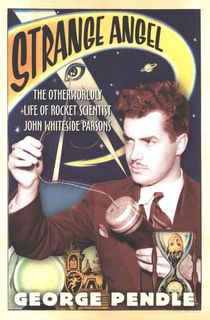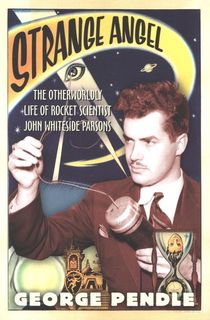Jack Parsons' life mirrors the plot of a sci-fi novel. Back in the first half of the 20th century, he made significant contributions to rocket engine technology, earning a reputation as a leader in scientific advancement. With a rough upbringing and only a high school education, his unexpected success opened his eyes to other possibilities—was there anything he couldn't achieve?
Parsons' curiosity brought him to the Church of Thelema, a religious group with occult ties, where he eventually met Scientology founder L. Ron Hubbard. So began a toxic professional relationship that would lead Parsons down a twisted path of black magic, to bankruptcy. Strapped for cash, he began collaborating with the Israeli rocket community, only to be accused of espionage and barred from pursuing his scientific dreams in the United States.
In 1952, Parsons and his wife visited Mexico, where he was temporarily employed by an explosives factory. He died from an explosion in his home laboratory later that year, despite having a knack for controlling even the most volatile substances. Police officially ruled his death an accident, but those closest to him believed it was suicide. Author George Pendle investigates the mystery of Parsons' death in his book Strange Angel, along with several other facets of this scientist’s shocking life.
Read on for an excerpt of George Pendle’s Strange Angel, and then download the book.
At 5:08 P.M. on June 17, 1952, an explosion rips through the warm, lush air that blankets the city of Pasadena. Those who are closest to the explosion will say that there were two almost simultaneous blasts. But by the time the sounds reach the famed mission-style dome of City Hall some two miles away from their source, they have fused into one indistinct eruption. People turn blindly to the sky, trying to find the source of the explosion. Tentatively at first, then more confidently, they dismiss it as construction noise or demolition work. Pasadena is changing rapidly these days.
Those to the south of the city center can pinpoint the noise a little better. It seems to have come from the edge of the Arroyo Seco, the wild valley that runs along the western border of Pasadena and separates the city from the encroaching sprawl of Los Angeles. Indeed, those near the Arroyo flinch and swing their heads instinctively toward the source of the sound—Orange Grove Avenue, that faded relic of the city’s glorious past better known as Millionaire’s Row.
On Orange Grove the explosion causes the magnolia trees to shudder. Heads appear out of windows and people stand frozen as the blast echoes off the few remaining white-washed mansions, ringing high over the empty lots and building sites. The sound does not come from the French manor house of John S. Cravens, former president of the Edison Company. Nor does it come from the Busch Gardens that had once played host to presidents and those even more powerful. The Macris estate, home to the reclusive oil heiress, stands unmoved.
No, the sound of the explosion came from 1071 South Orange Grove, the old Cruikshank estate.
But the old Cruikshank manor has long since been torn down. Once the home of California’s most prominent attorney, its place is taken now by some of the first condominiums to breach this once restricted area. They sit awkwardly alone, an air of incongruity hanging heavily on their modern frames as if membership to the street still eluded them. The explosion seemed to come from beyond them, down the long, serpentine drive that remains from the manor’s glory days. It is now clear that the blast came from the estate’s old coach house.
Loose sheaves of paper have been blown out onto the driveway and the surrounding lawn. Thin smoke cloaks the building. All but one of the large garage doors have been knocked from their hinges and lie askew on the ground, buckled and broken. The window frames hang glassless and limp from the wall. It is as if the building has disgorged itself. Getting closer, one can see that the doors previously enclosed a large room, although it is hard to make out the room’s exact dimensions since it is clogged with debris. The heavy timber frames from the ceiling have collapsed, and the floor is covered in splintered wood, broken plaster, and the unidentifiable confetti of destruction. The side walls have been stripped of their plaster, and the exposed wooden support struts loomed like a broken rib cage. The back wall has exploded outward, revealing a shattered greenhouse slumped some twenty-five feet away. There is an acrid, chemical smell in the room. The right-side wall bulges unnaturally, blocking shut the door to an adjacent room. There is a large hole, charred black, in the middle of the floor.
The room appears to have been used as a laundry. A dented boiler squats in the corner, its water pipes buckled and bent. A large cast-iron wash tub has been ripped from its fitting and lies wedged against the wall as if it had been tossed aside by an uninterested child. Two people, a young man and an older woman, are straining to move it. It is too heavy to lift, so they try to roll it away. Finally it tumbles onto its side. Beneath its white bulk they find a pool of blood and, lying in it, the singed and broken body of a man. They pull him to the wall as carefully as they can and prop him up. He looks like a life-sized rag doll. The man’s shoes have been shredded by the force of the explosion. His legs lie shattered and limp in front of him, unnaturally crooked. His white shirt is scorched black and stained red, the right sleeve flapping uselessly; there is no arm to fill it. But this is not the worst. The left side of the man’s face is slack and expressionless, and the right side appears to have disappeared altogether. The skin has been ripped off, exposing the white of jaw bone and teeth. One eye is open, the other appears not even to be there so covered in gore is the face. And there is the sound of groaning; despite his horrific injuries, the man is conscious.

Greg Ganci, who has just propped the body up, stands back in a daze. He is a young actor, in his mid-twenties, and has been renting one of the upstairs bedrooms for the past three weeks. He looks up and sees the hole in the ceiling that had appeared in his floor only moments before. Another boarder, Martin Foshaug, now comes downstairs and surveys the devastation. He called the police immediately after the explosion occurred. The older woman who had helped move the body, Foshaug’s mother, goes upstairs. She has something on the stove and doesn’t want it to boil over.
Ganci and Foshaug look at the devastation that surrounds them. As the smoke clears, the room seems to reveal itself as something other than a laundry. Around the body lie broken bottles made of thick dark glass, vials, flasks, and test tubes. The man continues to groan. Ganci says to Foshaug, “We’ve got to go and tell his wife.” As he turns to leave, he notices hypodermic needles spilling out of one of the overturned trash cans. He looks at Foshaug and back down at the needles. “We don’t want to be accused of taking drugs,” he says with sudden urgency. They sweep them up and dispose of them as the sound of sirens emerges in the distance.
Reams of paper continue to waft around and out of the room, brushing up against the groaning, half-dead man. Some carry abstruse chemical formulas, sketches of molecular composition, and long streams of tables and equations. Neatly clipped newspaper cuttings singed by the heat of the explosion tell tales of blasts in shipyards and bombs placed under cars, of massive loss of life and unexplained causes. The garishly colored covers of science fiction magazines float by, ripped from their staples, tattered and torn. Other pages have strange symbols on them, pentagrams, cabalistic charts, and writing in unintelligible languages. As the sirens get louder and louder, the paper seems to swathe the crushed body like bandages.
Ganci is driving quickly along Orange Grove toward 424 Arroyo Terrace, a couple of miles to the north. The door is not opened by the wife Ganci expected to see, but rather by the mother, sixty-one-year-old Ruth Parsons, who has been taking care of the house for the summer. Her son and daughter-in-law have been staying with her for the past few weeks prior to a long-planned holiday, and their suitcases line the corridor. It is the first time that Ruth Parsons has lived with her son since he was a child. Ganci speaks, trying to catch his breath, “Mrs. Parsons,” he says, “Jack has been injured in an explosion in the house.” There is the slightest of pauses before Ruth Parsons screams. She covers her mouth with her hand, gasping for breath. “Oh, my God!” she screams over and over again. Ganci helps her to a chair and sits with her for a few long minutes. As her sobs slowly quiet, Ganci speaks again, “Mrs. Parsons, he’s very badly hurt. There’s a possibility that he may not live.” Ruth Parsons screams and groans again. Ganci, not knowing quite what to do, says he will send word about her son’s progress, and leaves her.
By the time he returns to the coach house, Jack Parsons, still conscious, has been rushed to Huntingdon Memorial Hospital. The ambulance crew inform the arriving newspaper reporters that Parsons had struggled to tell them something, but the wounds to his face would not allow him to speak. They had tried, but could not find the rest of his right arm. In the coach house police investigators have their notepads out and are trying to ascertain the cause of the explosion. Ganci and Foshaug describe what happened as best they can. They were the man’s tenants. They had known him only for a few months. Just outside the garage door, unaffected by the blast, are several boxes full of glass bottles labelled DANGER—EXPLOSIVES. The reporters photograph the police investigator as he works his way through the rubble; he estimates that there are enough explosives still remaining in the laboratory to “blow up half the block.” He puts a call through to the army’s Fifty-eighth Ordnance Disposal Unit to remove them and quickly covers some of the bottles so the camera flashes won’t ignite any light-sensitive chemicals.
Some twenty or so reporters and photographers are now at the scene of the blast, walking in and around the building, reading the scraps of paper that lie strewn across the floor. A local newspaperman finds a fragment of legible handwriting. It reads, “Let me know the misery totally. And spare not and be not spared. Sacrament and Crucifixion. Oh my passion and shame.”
Amidst this confusion of police and press, Marjorie Cameron Parsons, Jack Parsons’ wife, returns to the coach house in a car pulling a trailer. The reporters, sensing a widow in the making, swarm around her. Stunned as she is, all she can say is that her husband was a chemist, that she is an artist, and that they were due to leave for Mexico that very day for a holiday. In fact, they were going to leave as soon as her husband had finished working with his chemicals. Some of the more inquisitive reporters lift up the tarpaulin covering the trailer. It contains canvases, paints, a record player, archery equipment, and fencing foils. Marjorie Parsons gets back into her car and drives to the hospital. However, by the time she arrives, her husband, John Whiteside Parsons, known as Jack to his friends, has been declared dead. He was thirty-seven years old.
Want to keep reading? Download Strange Angel today!
Feature photo: Alchetron


